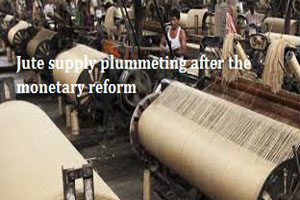
Jute supply plummeting after the monetary reform
YarnsandFibers News Bureau 2016-12-07 15:00:00 – CalcuttaWith the decline of cotton supply to textile units vis-a vis demonetization, the jute supply is also following a similar trend. The supply of raw jute to mills estimated a disruption in the sourcing of Rs 4,000-crore worth of the fibre from rural and secondary markets in the absence of a payment arrangement.
The production of raw jute stands at 90 lakh bales so far this fiscal. According to industry sources, only 40-45 per cent of the output have reached the market.The conversion of raw jute into finished product involves a three-tier market structure comprising farmers, traders and mills.
According to mill owners, the Centre has instructed operational units to take initiatives to arrange wage payments for employees through banks.Close to 90 per cent of the work regarding the opening of bank accounts of jute mill workers is over.
A mill owner said that the worst-affected area of operation is in the villages where farmers and stockists are unable to dispose of their produce. Restriction in cash supply by the banks has blocked the release of stock because farmers and dealers are unable to encash cheques. The transportation of jute from the rural markets to the mills has also become difficult.
He added that though mills may try to regularise the payment of wages to the employees, there is uncertainty over production in the coming days because of the non-availability of the raw material.
Raghavendra Gupta, chairman of the Indian Jute Mills Association (Ijma), in a letter to state labour minister Moloy Ghatak last month that presently most of the jute mill companies do not have raw jute stock beyond one month normal production capacity. There is a shortage of cash in the system affecting trade because of demonetisation and limitation on withdrawal from bank accounts.
Ijma has suggested intervention by the Jute Corporation of India for direct purchase of raw fibre through commercial operation and making it available in the market for the mills.
Bengal, which contributes around three-fourth to the total production of the fibre in the country, has 15 jute growing districts. Of these, 24 Parganas, Hooghly, Nadia, Murshidabad and Dinajpur are high productivity districts.
Market Intelligence
Ask for free sample Report

experience
Customer Base
dedicated team
Countries Served Worldwide









